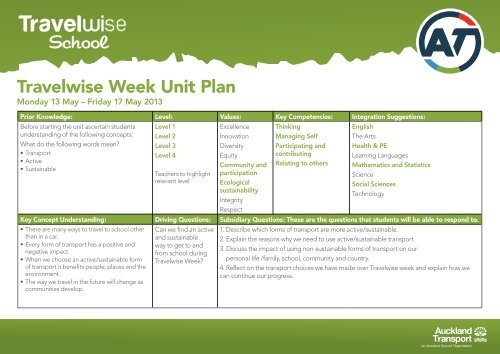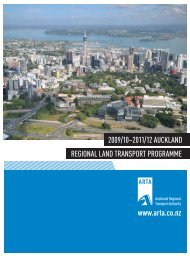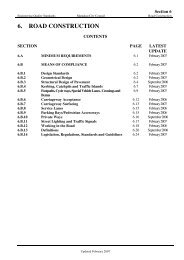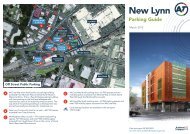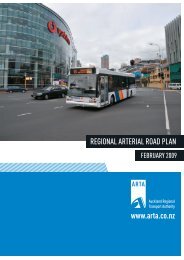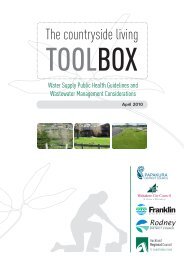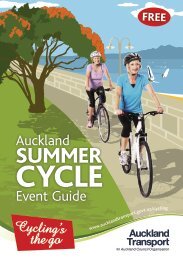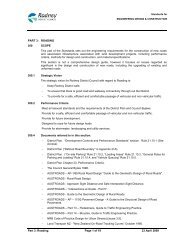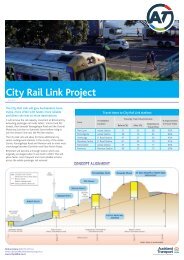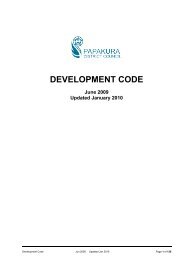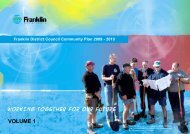Travelwise Week Unit Plan - Auckland Transport
Travelwise Week Unit Plan - Auckland Transport
Travelwise Week Unit Plan - Auckland Transport
You also want an ePaper? Increase the reach of your titles
YUMPU automatically turns print PDFs into web optimized ePapers that Google loves.
<strong>Travelwise</strong> <strong>Week</strong> <strong>Unit</strong> <strong>Plan</strong><br />
Monday 13 May – Friday 17 May 2013<br />
Prior Knowledge: Level: Values: Key Competencies: Integration Suggestions:<br />
Before starting the unit ascertain students<br />
understanding of the following concepts:<br />
What do the following words mean?<br />
• <strong>Transport</strong><br />
• Active<br />
• Sustainable<br />
Level 1<br />
Level 2<br />
Level 3<br />
Level 4<br />
Teachers to highlight<br />
relevant level<br />
Excellence<br />
Innovation<br />
Diversity<br />
Equity<br />
Community and<br />
participation<br />
Ecological<br />
sustainability<br />
Integrity<br />
Respect<br />
Thinking<br />
Managing Self<br />
Participating and<br />
contributing<br />
Relating to others<br />
English<br />
The Arts<br />
Health & PE<br />
Learning Languages<br />
Mathematics and Statistics<br />
Science<br />
Social Sciences<br />
Technology<br />
Key Concept Understanding: Driving Questions: Subsidiary Questions: These are the questions that students will be able to respond to.<br />
• There are many ways to travel to school other<br />
than in a car.<br />
• Every form of transport has a positive and<br />
negative impact.<br />
• When we choose an active/sustainable form<br />
of transport it benefits people, places and the<br />
environment.<br />
• The way we travel in the future will change as<br />
communities develop.<br />
Can we find an active<br />
and sustainable<br />
way to get to and<br />
from school during<br />
<strong>Travelwise</strong> <strong>Week</strong>?<br />
1. Describe which forms of transport are more active/sustainable.<br />
2. Explain the reasons why we need to use active/sustainable transport.<br />
3. Discuss the impact of using non-sustainable forms of transport on our<br />
personal life /family, school, community and country.<br />
4. Reflect on the transport choices we have made over <strong>Travelwise</strong> week and explain how we<br />
can continue our progress.<br />
<strong>Travelwise</strong> <strong>Week</strong> <strong>Unit</strong> <strong>Plan</strong>
Achievement Objectives<br />
Learning Intentions:<br />
Learning Experiences:<br />
Select the achievement objectives that best match<br />
the abilities of your students.<br />
Speaking, Writing & Presenting<br />
Students will:<br />
Purposes and audiences<br />
• Recognise that texts are shaped for<br />
different purposes and audiences. (Level 1)<br />
• Show some understanding of how to<br />
shape texts for different purposes and<br />
audiences. (Level 2)<br />
• Show a developing understanding of how<br />
to shape texts for different purposes and<br />
audiences. (Level 3)<br />
• Show an increasing understanding of how<br />
to shape texts for different purposes and<br />
audiences.(Level 4)<br />
Ideas<br />
• Form and express ideas on a range of<br />
topics. (Level 1 )<br />
• Select, form and express ideas on a range<br />
of topics. (Level 2)<br />
• Select, form, and communicate ideas on a<br />
range of topics. (Level 3)<br />
• Select, develop, and communicate ideas<br />
on a range of topics.(Level 4)<br />
Language Features<br />
• Use language features showing some<br />
recognition of their effects. (Level 1)<br />
• Use language features appropriately,<br />
showing some understanding of their<br />
effects. (Level 2)<br />
• Use language features appropriately,<br />
English<br />
WALT: (Level 1)<br />
• List all the ways we can get to school<br />
• Write a set of directions<br />
• Identify the positive and negative (good and bad) things<br />
about each type of transport<br />
• Create a display using the key words, ideas and images<br />
based on the theme<br />
• Write a set of directions showing how we get to school<br />
• Brainstorm a set of rules to stay safe in vehicles<br />
• Write about how we get to and from school each day<br />
• Read non-fiction books on the topic of transport<br />
• Write a poem with a <strong>Travelwise</strong> theme<br />
Insert the name of the poem model e.g. Sense<br />
WALT: (Level 2)<br />
• Write a set of directions that someone else can follow<br />
• Plot our route on a map<br />
• Write a set of instructions for someone who has never<br />
travelled on public transport before<br />
• Write a set of rules/guidelines for travelling safely to and from<br />
school on a chosen mode of transport<br />
• Write a letter to the Principal using persuasive language to<br />
outline an issue of concern<br />
• Create a postcard that has the following elements:<br />
• address<br />
• brief message<br />
• illustration<br />
• Use different mediums to recount our travel experiences<br />
during <strong>Travelwise</strong> <strong>Week</strong><br />
• Explain in writing how something works or happens<br />
• Create an advertisement that has the following features:<br />
Learning Experiences<br />
Select the learning experiences that best match the abilities of your<br />
student and that support your learning intentions. You may choose<br />
to structure these learning experiences within an inquiry cycle as a<br />
means of achieving effective thinking and action outcomes. Developing<br />
students’ action competence is a key outcome of road safety<br />
education.<br />
Procedural Writing<br />
1. List – How many ways can you get to school?<br />
(Level 1)<br />
Class to brainstorm and discuss all the different ways you can<br />
get to and from school.<br />
Introduce key words such as walk, bike, scooter, bus, train, car<br />
etc…<br />
Introduce and discuss the key concepts such as transport,<br />
active and sustainable.<br />
Ask the class to identify the advantages (good things),<br />
disadvantages (bad things) for each type of transport.<br />
Compare and contrast these. Students can choose a type of<br />
transport they like and draw a picture to illustrate it.<br />
Create a display using the list, the key words, concepts ,<br />
pictures, images, advantages and disadvantages.<br />
2. Directions (Level 1,2,3,4)<br />
Students can write a set of directions showing how they<br />
travelled to and from school using their chosen mode of<br />
transport (e.g. walking, cycling, scooting, catching the bus<br />
or train).<br />
They can then plot the route they travelled on a local map. The<br />
whole class may wish to plot their routes on a larger map and<br />
label with photos, comments and observations.<br />
<strong>Travelwise</strong> <strong>Week</strong> <strong>Unit</strong> <strong>Plan</strong>
showing a developing understanding of<br />
their effects. (Level 3)<br />
• Use a range of language features<br />
appropriately, showing an increasing<br />
understanding of their effects. (Level 4)<br />
Structure<br />
• Organise texts using simple structures.<br />
(Level 1)<br />
• Organise texts, using a range of structures.<br />
(Level 2)<br />
• Organise texts, using a range of<br />
appropriate structures. (Level 3)<br />
• Organise texts using a range of<br />
appropriate structures.(Level 4)<br />
Processes and strategies<br />
• Integrate sources of information,<br />
processes, and strategies with developing<br />
confidence to identify, form and express<br />
ideas. (Level 3)<br />
• Integrate sources of information,<br />
processes, and strategies confidently to<br />
identify, form and express ideas. (Level 4)<br />
English – Listening, Reading &<br />
Viewing<br />
Purposes and audience<br />
• Recognise that texts are shaped for<br />
different purposes and audiences. (Level 1)<br />
• Show some understanding of how texts<br />
are shaped for different purposes and<br />
audiences. (Level2)<br />
• Show a developing understanding of how<br />
texts are shaped for different audiences<br />
and purposes. (Level 3)<br />
• Show an increasing understanding of how<br />
texts are shaped for different purposes<br />
and audiences. (Level 4)<br />
• a clear <strong>Travelwise</strong> message<br />
• clear font, format and colour<br />
• event details (where, when, what etc.)<br />
• Create a brochure that has the following elements:<br />
• a description of each type of transport<br />
• an illustration that supports text<br />
• Read a news article and identify the who, what, when, where,<br />
why/how<br />
• Read non-fiction books on the topic of transport<br />
• Write a poem with a <strong>Travelwise</strong> theme<br />
Insert the name of the poem model e.g. Acrostic<br />
WALT: (Level 3)<br />
• Write a detailed set of directions that someone else can<br />
follow<br />
• Plot our route on a map and add a scale and key<br />
• Write a detailed set of instructions for someone who has<br />
never used public transport.<br />
(Insert the mode of transport chosen e.g. bus)<br />
• Write a letter to the Principal using persuasive language to<br />
outline an issue of concern and a potential solution<br />
• Create a postcard that has the following elements:<br />
• address<br />
• brief message<br />
• illustration<br />
• descriptive language (to describe physical features; land<br />
marks, road safety etc…)<br />
• Use different mediums to recount our travel experiences<br />
during <strong>Travelwise</strong> <strong>Week</strong><br />
• Explain in writing how something works or happens and<br />
provide labels and a diagram to support it<br />
• Design an advertisement that has the following features:<br />
• a clear <strong>Travelwise</strong> message<br />
• persuasive language (emotive words)<br />
• clear font, format and colour<br />
• event details (where, when, what etc.)<br />
• Create a brochure that has the following elements:<br />
• a description of each type of transport used<br />
3. Instructions (Level 2,3,4)<br />
Students can write a set of instructions for how to catch a bus,<br />
train or ferry. Students can use their school as a starting point .<br />
They may want to consider including the following elements:<br />
• location of bus station/stop, train station or ferry terminal<br />
• time table<br />
• cost (ticket)<br />
• duration of trip<br />
• potential hazards to avoid<br />
4.Rules/Guidelines (Level 1,2,3,4)<br />
Get students to brainstorm and record a set of rules/guidelines<br />
for one of the following topics:<br />
• Riding on a bus/train<br />
• Walking to school<br />
• Riding a bike/skateboard/scooter to school<br />
(Refer to the Ministry of Education: School <strong>Transport</strong> Fact Sheets 7,8,9<br />
for information on buses).<br />
Extension: Create a class or school Road Safety Policy.<br />
4. Letter to the Principal (Level 3,4)<br />
Whole class - shared writing, group, individual<br />
Class to brainstorm road safety issues and traffic problems<br />
that may affect their school (e.g. cars speeding, air pollution,<br />
people parking on yellow lines).<br />
Get students to identify possible actions the school could<br />
take to solve some of these issues. Students can write a letter<br />
to the principal stating what their issue is, providing some<br />
background information and putting forward their ideas to<br />
resolve it.<br />
Extension: Write a Letter to the Editor of a local newspaper.<br />
5. Postcard (Level 2,3)<br />
This is a creative activity.<br />
Ask the students to choose another area in their region, do<br />
some research on the place and work out how they could<br />
travel there sustainably.<br />
<strong>Travelwise</strong> <strong>Week</strong> <strong>Unit</strong> <strong>Plan</strong>
Ideas<br />
• Recognise and identify ideas within and<br />
across texts. (Level 1)<br />
• Show some understanding of ideas within,<br />
across, and beyond texts. (Level 2)<br />
• Show a developing understanding of ideas<br />
within, across, and beyond texts. (Level 3)<br />
• Show an increasing understanding of ideas<br />
within, across, and beyond texts. (Level 4)<br />
Language features<br />
• Recognise and understand how language<br />
features are used for effect within and<br />
across texts. (Level 1)<br />
• Show some understanding of how<br />
language features are used for effect<br />
within and across texts. (Level 2)<br />
• Show a developing understanding of<br />
how language features are used for effect<br />
within and across texts. (Level 3)<br />
• Show an increasing understanding of<br />
how language features are used for effect<br />
within and across texts. (Level 4)<br />
Structure<br />
• Recognise and begin to understand text<br />
structures. (Level 1)<br />
• Show some understanding of text<br />
structures. (Level 2)<br />
• Show a developing understanding of text<br />
structures (Level 3)<br />
• Show an increasing understanding of text<br />
structures. (Level 4)<br />
• illustration that supports text<br />
• a diagram of the local area<br />
• Write a news article about one event that occurred during<br />
<strong>Travelwise</strong> <strong>Week</strong><br />
• Write and perform a rap for <strong>Travelwise</strong> <strong>Week</strong><br />
• Read a news article and identify the who, what, when, where,<br />
why/how<br />
• Use reciprocal reading strategies to analyse a news article<br />
• Read non-fiction books on the topic of transport<br />
• Write a poem with a <strong>Travelwise</strong> theme<br />
Insert the name of the poem model e.g. Haiku<br />
WALT: (Level 4)<br />
• Write a detailed set of directions that someone else can<br />
follow<br />
• Plot our route on a map and add a scale, key and some<br />
photos<br />
• Write a detailed set of instructions for someone who has<br />
never used public transport.<br />
(Insert the mode of transport chosen e.g. bus)<br />
• Write a set of rules/guidelines for travelling safely to and from<br />
school on your chosen mode of transport<br />
• Create our own Road Safety Policy<br />
• Write a letter to the Principal using persuasive language to<br />
outline an issue of concern and a potential solution<br />
• Write a Letter to the Editor of a Local newspaper canvassing<br />
community support for a transport problem<br />
• Use different mediums to recount our travel experiences<br />
during <strong>Travelwise</strong> <strong>Week</strong><br />
• Explain in writing how something works or happens and<br />
provide labels, maps and diagrams to support it<br />
• Design an advertisement that has the following features:<br />
• a clear <strong>Travelwise</strong> message<br />
• persuasive language (emotive words)<br />
• clear font, format and colour<br />
• event details (where, when, what etc.)<br />
• Create a brochure that has the following elements:<br />
• a description of each type of transport used<br />
Pose the question:<br />
Imagine you are visiting this place. I want you to write a postcard to<br />
your family explaining how you got to this destination and describe<br />
some landmarks you saw on the way.<br />
The postcard should have: a colourful and detailed picture on<br />
the front, an address, a brief and informative message and be<br />
original.<br />
Recount Travel Journal/Diary/Blog<br />
(Level 1)<br />
Ask each student to write about their trip to school that day.<br />
(Level 2,3,4)<br />
Get each student to record how they got to and from<br />
school over <strong>Travelwise</strong> <strong>Week</strong> and the experiences they had<br />
in the process. Mediums might include: a written, video,<br />
photographic diary, journal or class blog.<br />
<strong>Travelwise</strong> <strong>Week</strong> Poster/Advertisement (Level 2,3,4)<br />
Students can design a poster advertising <strong>Travelwise</strong> <strong>Week</strong>.<br />
When creating it they should consider features such as: details<br />
of the event (date, time, activities, and location), message<br />
(purpose), layout (colour, images, font, and symbols), and<br />
audience (who is it aimed at) and gimmicks.<br />
<strong>Travelwise</strong> Brochure (Level 2,3,4)<br />
Students can design their own <strong>Travelwise</strong> Brochure<br />
showing different ways to get to school (walking, scooting,<br />
skateboarding, cycling etc…), include a map with good routes<br />
and the health benefits.<br />
Explanations (Level 2,3,4)<br />
1. Get the class to choose a road safety topic.<br />
2. Make a list of all the things they already know about<br />
the topic.<br />
3. Write down the things they will need to find out and<br />
the places to do their research.<br />
<strong>Travelwise</strong> <strong>Week</strong> <strong>Unit</strong> <strong>Plan</strong>
• an illustration that supports text<br />
• a diagram of the local area<br />
• some symbols identifying pedestrian/kea crossings,<br />
cycle paths etc…<br />
• Write a news article about one event that occurred during<br />
<strong>Travelwise</strong> <strong>Week</strong><br />
• Add more detail to our news article by using features such as:<br />
• a photograph<br />
• a direct quote/vox pop<br />
• a breakout quote<br />
• an eyewitness account<br />
• a diagram/map/statistics box<br />
• Write and perform a rap for <strong>Travelwise</strong> <strong>Week</strong><br />
• Video and upload our rap to a form of social media (e.g.<br />
YouTube)<br />
• Use reciprocal reading strategies to analyse a news article<br />
• Read non-fiction books on the topic of transport<br />
4. Make notes on the subject.<br />
5. Organise the information into sub headings.<br />
6. Write an explanation, add labels, diagrams, graphs<br />
and tables.<br />
Ideas for explanations might include:<br />
• How Traffic Lights Work<br />
• What happens when a car pollutes the air<br />
News Article (individual/group) (Level 3,4)<br />
Students can write a news article detailing one school event<br />
that ran during <strong>Travelwise</strong> <strong>Week</strong>.<br />
A news article:<br />
• has a title, by-line, introduction, main body and conclusion<br />
• is based on facts (factual)<br />
• may include eye witness accounts, quotes, vox pops, statistic<br />
boxes, maps, diagrams, comments and opinions<br />
• may have pictures to support the story<br />
The news article could be placed in the school newsletter or<br />
on the school website, Knowledge Net or Wiki Page<br />
<strong>Travelwise</strong> Rap (Level 3,4)<br />
A rap is when a person chants or rhymes lyrics in time to a musical<br />
beat. It has 3 main components: content, flow and delivery.<br />
Students can write and perform a rap to showcase all the things<br />
they have, done, learnt, seen or experienced during <strong>Travelwise</strong><br />
<strong>Week</strong>. See YouTube examples below:<br />
<strong>Travelwise</strong> Rap by Nikau Syndicate – www.youtube.com/<br />
watch?v=gTXOz=AZ8_fl<br />
Riverhills School <strong>Travelwise</strong> Rap – www.youtube.com/<br />
watch?v=7qnRfEnRY_o<br />
The rap can be performed live, recorded, and videoed and<br />
uploaded to a secure website.<br />
<strong>Travelwise</strong> Poetry (Level 1, 2, 3)<br />
Students can write a range of poems for <strong>Travelwise</strong> <strong>Week</strong>.<br />
Models that lend themselves well to the topic are: Free Verse.<br />
Acrostic, Shape, Sense and Haiku Poems<br />
<strong>Travelwise</strong> <strong>Week</strong> <strong>Unit</strong> <strong>Plan</strong>
Reading Tumbles:<br />
Centres that teachers may want to include for <strong>Travelwise</strong> <strong>Week</strong><br />
include:<br />
• Read around the room – have a variety of <strong>Transport</strong>,<br />
Road Safety, Health or Sustainability posters, pamphlets<br />
or diagrams placed around the classroom (age/interest<br />
appropriate)<br />
• Class library with topic based books<br />
• Discovery Table with books and items based on the theme<br />
(e.g. Exercise = shorts, t-shirt, running shoes, cycle helmet,<br />
pedometer, high visibility vest, bike, skateboard, scooter,<br />
wrist bands, stop watch, knee pads, elbow pads, mouth<br />
guard, sunglasses, bus pass, WSB ticket<br />
Extension: Put bike, skateboard, and scooter parts instead<br />
which will build intrigue, exploration and discussion.<br />
Current Events: Ask the students to bring news articles on<br />
different types of transport to school. Encourage them to look<br />
at both local and national newspapers.<br />
News Book – Shared Reading (Level 1-4)<br />
• Class to read and analyse news article focusing on the<br />
inquiry questions: Who? What? When? Where? Why? How?<br />
News Book (Level 3-4)<br />
Group Reciprocal Reading<br />
• Give each group a different news article<br />
• Get them to predict what the story is about<br />
(using the visual clues)<br />
• Read the article and highlight key words<br />
• Assess whether their predictions were correct and clarify<br />
unknown vocabulary<br />
• Ask questions<br />
• Summarise main ideas<br />
<strong>Travelwise</strong> <strong>Week</strong> <strong>Unit</strong> <strong>Plan</strong>
Social Sciences<br />
Students will gain knowledge, skills<br />
and experience to:<br />
Level 1<br />
• Understand that people have different<br />
roles and responsibilities as part of their<br />
participation in groups.<br />
Level 2<br />
• Understand how people make choices to<br />
meet their needs and wants.<br />
• Understand how places influence people<br />
and people influence places<br />
Level 3<br />
• Understand how people make decisions<br />
about access to and use of resources.<br />
Level 4<br />
• Understand how formal and informal<br />
groups make decisions that impact on<br />
communities.<br />
• Understand how people participate<br />
individually and collectively in response to<br />
community challenges.<br />
Social Sciences<br />
WALT : (Level 1)<br />
• Identify what groups drive in the community. Why?<br />
• Compare and contrast people who drive for a job<br />
(professionally) and those who drive for family or<br />
personal reasons<br />
WALT: (Level 2)<br />
• Identify the advantages and disadvantages of using a mode<br />
of transport<br />
• Evaluate which mode of transport is most active and/or<br />
sustainable<br />
• Pose problems involving transport and create possible<br />
solutions to address the issues<br />
• Assess issues and rank according to personal experience and<br />
discuss the impact of each issue<br />
• Compare and contrast two modes of transport in relation to<br />
set criteria. (i.e. health benefits, amount of resources used,<br />
environmental impact)<br />
WALT: (Level 3)<br />
• Compare and contrast different modes of transport<br />
• Explain why people choose to use different kinds of transport<br />
• Discuss the environmental impact of the transport choices<br />
we make<br />
• Assess issues and rank according to different perspectives<br />
(e.g. family, school, businesses, government) and discuss the<br />
impact of each issue<br />
WALT: (Level 4)<br />
• <strong>Plan</strong> and implement positive transport choices within the<br />
class, school and/or community<br />
To do the above the following WALTs will also need to be covered<br />
before a plan is made.<br />
Social Sciences / English<br />
The activities shown below examine the reasons why <strong>Travelwise</strong> <strong>Week</strong><br />
was developed and peoples roles and responsibilities as members<br />
of a school and community. They can be used as isolated activities<br />
to build understanding or as part of an Inquiry Learning Approach.<br />
Either way they are springboard to further inquiry.<br />
Y- Chart (Level 1)<br />
The Y-Chart requires students to brainstorm ideas around<br />
three dimensions – What it looks like, sounds like and feels like.<br />
This activity encourages students to apply their senses and<br />
observations to the world around them.<br />
Use the template to:<br />
• Choose a form of transport (e.g. walking or catching a bus)<br />
and apply the 3 dimensions.<br />
• Think about what it’s like to be a passenger in a car driven by<br />
….mum/dad/uncle/aunty/grandparents/care-givers.<br />
Extension: Examine the roles of different people who drive<br />
in the community i.e. Bus Drivers, Train Drivers, Ferry Captains,<br />
Walking School Bus Drivers, Ambulance Drivers, Police, Firefighters<br />
• What is the similarity or difference between these drivers<br />
and family members who drive?<br />
(PMI) Plus Minus Interesting Chart (Level 2,3,4)<br />
This chart helps students explore an issue of interest, identify<br />
the advantages/disadvantages and compare, contrast and<br />
evaluate an issue.<br />
It is a useful decision making tool when comparing the<br />
benefits/costs of using different modes of transport.<br />
• Cars v Walking<br />
• Car v using a bus/train<br />
• Walking v cycling<br />
• Vehicles v environment<br />
• Petrol Cars v electric cars<br />
<strong>Travelwise</strong> <strong>Week</strong> <strong>Unit</strong> <strong>Plan</strong>
• Identify the current modes of transport to and from school<br />
and assess the impact of their current choices on our family,<br />
school and community<br />
• Research alternative modes of transport available (with<br />
thought to how it impacts on health, time, cost and the<br />
environment)<br />
• Compare and contrast the alternatives identified, rank them<br />
according to an agreed criteria and choose an option to<br />
explore further that would benefit your class, school and/or<br />
community<br />
The Fishbone Activity (Level 2,3,4)<br />
This activity provides a way of thinking about a problem. The<br />
head of the fish is the Problem posed, the scales on one side<br />
are the Cause and the other side is the Effect. The tail holds<br />
Potential Solutions.<br />
Examples of problems posed may include:<br />
Too many cars on the road cause traffic congestion<br />
and people are late for work and school.<br />
More people are becoming unfit and overweight because they<br />
drive everywhere.<br />
Cars pollute the air and humans breathe.<br />
Parents are afraid to let their children walk or cycle to school.<br />
Extension: Replace the Cause and Effect labels with deBono’s<br />
Thinking Hats<br />
Diamond Ranking: (Level 2, 3,4)<br />
Pose a question: (examples shown below)<br />
• Will the transport we use now have a long term effect on the<br />
environment?<br />
• What types of transport will exist in 50 years from now and<br />
how will it change the way we travel?<br />
• Will transport change the way communities look in the<br />
future?<br />
In groups get students to brainstorm as many answers to the<br />
question as they can think of.<br />
Write each answer on a piece of paper and rank it in a diamond<br />
pattern (see template) from Most Important to Least Important.<br />
Share your answers with the class and discuss the reasoning<br />
behind your choices.<br />
Venn Diagram (Level 3,4)<br />
Students use a Venn diagram to compare two things, people,<br />
places, events or issues. By recording aspects of similarity in<br />
the overlapping circle and aspects of difference in separate<br />
sections of the circles they can compare them.<br />
Get students to create their own Venn Diagram using two<br />
forms of transport (e.g. car and bus, bike and skateboard, bus<br />
and train, car and walking)<br />
<strong>Travelwise</strong> <strong>Week</strong> <strong>Unit</strong> <strong>Plan</strong>
Health and Physical Education<br />
Strands:<br />
Regular physical activity:<br />
• Participate in creative and regular<br />
physical activities and identify enjoyable<br />
experiences. (Level 1)<br />
• Experience creative, regular, and enjoyable<br />
physical activities and describe the<br />
benefits to well-being. (Level 2)<br />
• Maintain regular participation in<br />
enjoyable physical activities in a range of<br />
environments and describe how these<br />
assist in the promotion of well-being.<br />
(Level 3)<br />
• Demonstrate an increasing sense of<br />
responsibility for incorporating regular<br />
and enjoyable physical activity into their<br />
personal lifestyle to enhance well-being.<br />
(Level 4)<br />
Community resources<br />
• Identify and discuss obvious hazards in<br />
their home, school, and local environment<br />
and adopt simple safety practices. (Level 1)<br />
• Identify and use local community resources<br />
and explain how these contribute to a<br />
healthy community (Level 2)<br />
• Participate in communal events and<br />
describe how such events enhance the<br />
well-being of the community (Level 3)<br />
• Investigate and/or access a range of<br />
community resources that support wellbeing<br />
and evaluate the contribution made<br />
by each to the well-being of community<br />
members (Level 4)<br />
Health and Physical Education<br />
WALT: (Level 1-4) Modify according to level.<br />
• Understand the link between the choices we make and our<br />
well-being<br />
• Make statements about our choices and the way we impact<br />
the environment<br />
• Explain how a job can positively or negatively affect a<br />
person’s well-being (physically and mentally)<br />
Why walk?<br />
Ask students to investigate the benefits of walking instead<br />
of travelling by car. When brainstorming ideas, consider the<br />
following categories:<br />
Hauora – Well-being<br />
• Taha Tinana (Physical well-being)<br />
• Taha Hinengaro (Mental & Emotional well-being - selfconfidence)<br />
• Taha Whanau (Social well-being - self-esteem)<br />
• Taha Wairua (Spiritual well-being - personal beliefs).<br />
Level 1 – Class to brainstorm. Teacher to help students<br />
investigate more in depth.<br />
Level 2 – Group to brainstorm using the four headings of<br />
Hauora. Students to write inquiry based questions as a group<br />
to find out more in depth information with teacher support.<br />
Level 3 - Group to brainstorm using the four headings of<br />
Hauora. Each group to choose a category to research more in<br />
depth.<br />
Level 4 – Students to share their ideas with a peer and then<br />
report back to the class. Students to record each other’s ideas<br />
and choose an area to research more in depth.<br />
E.g. What happens to people who do not look after their health?<br />
• Students to look at how lack of physical activity, good food<br />
and nutrition can affect a person’s overall wellbeing.<br />
Level (1,2,3) What does healthy and happy look like?<br />
Get students to draw a picture of what they think a healthy<br />
person looks like. They could draw this person getting to<br />
places in a healthy way. They could draw a well balanced<br />
meal they might eat. From there they can brainstorm healthy<br />
lifestyle activities this person enjoys e.g. being smoke free,<br />
exercising, meeting friends, going to church, playing on a<br />
sports team and volunteering in the community.<br />
Level 4<br />
Ask students to discuss the sorts of problems that an<br />
unhealthy lifestyle can create. Get them to create a table<br />
<strong>Travelwise</strong> <strong>Week</strong> <strong>Unit</strong> <strong>Plan</strong>
Rights, responsibilities, and laws/<br />
People and the Environment<br />
• Take individual and collective action to<br />
contribute to environments that can be<br />
enjoyed by all (Level 1)<br />
• Contribute to and use simple guidelines<br />
and practices that promote physically and<br />
socially healthy classrooms, schools, and<br />
local environments (Level 2)<br />
• Research and describe current health and<br />
safety guidelines and practices in their<br />
school and take action to enhance their<br />
effectiveness (Level 3)<br />
• <strong>Plan</strong> and implement a programme to<br />
enhance an identified social or physical<br />
aspect of their classroom or school<br />
environment (Level 3)<br />
• Specify individual responsibilities and<br />
take collective action for the care and<br />
safety of other people in their school and<br />
in the wider community (Level 4)<br />
with three columns (Cause, Effect and Solution) and list their<br />
ideas for for the first two. Now ask them to imagine they have<br />
been asked to provide advice on lifestyle changes that could<br />
improve the health and wellbeing of people who suffer from<br />
some of these problems.<br />
Example: Smoking<br />
Cause – Smoking<br />
Effect – Shortness of breath, asthma, lung cancer, premature aging<br />
Solution – Advice would be to stop smoking with the aid of a<br />
proven social service such as Quitline.<br />
The Big Picture (Levels 1-4, mini inquiry)<br />
In what ways does using active/ sustainable transport impact<br />
on the environment?<br />
Ask students to think about how the following things impact<br />
the environment:<br />
• pollution (e.g. petrol fumes, rubbish)<br />
• trees being cut down and land cleared to make roads<br />
• the amount of energy and resources used to make car parts<br />
If we continue to put more and more cars on the road, what do<br />
you think <strong>Auckland</strong> will look in 50 years time?<br />
Jobs and Health (Level 1-4)<br />
• Students to brainstorm a list of jobs. Which jobs require<br />
people to be active? Which jobs are inactive?<br />
• Sort into categories (e.g. Level 1 Completely Inactive e.g. a<br />
job where people sit down for most of the day through to<br />
Level 5 - Completely Active e.g. a professional athlete).<br />
• Choose 5 different jobs from across the lev allowances<br />
for this in the way you live your life? els and assess them<br />
according to criteria such as : physical activity, nutrition, stress<br />
levels, social satisfaction, community involvement, sense of<br />
achievement etc…<br />
Please note that answers will be from a student’s perspective<br />
and consequently varied.<br />
• Pose questions: Does a job affect a person’s lifestyle? If so,<br />
what does this mean for people who work in these jobs? E.g.<br />
If your job involved sitting down a lot, would you need to<br />
make allowances for this is the way you live your life?<br />
<strong>Travelwise</strong> <strong>Week</strong> <strong>Unit</strong> <strong>Plan</strong>
Mathematics & Statistics<br />
Measurement<br />
• Give and follow instructions for movement,<br />
that involves distances, directions, and half<br />
or quarter turns.(Level 1)<br />
• Create and use appropriate units and<br />
devices to measure length. (Level 2)<br />
• Use linear scales and whole numbers of<br />
metric units, for length, area, volume,<br />
capacity, weight, angle, emperature and<br />
time. (Level 3)<br />
• Convert between metric units, using whole<br />
numbers and commonly used decimals.<br />
(Level 4)<br />
Mathematics and Statistics<br />
WALT: (Level 1-4)<br />
• Estimate and count our steps to a chosen destination<br />
• Convert metres into kilometres<br />
How Many Steps?<br />
Level 1 – Ask students to estimate and record how many<br />
steps they will need to take to reach different places in the<br />
classroom.<br />
See template below for example of table.<br />
Steps Estimate Actual<br />
From desk to door 35 51<br />
Please note that every child has a different foot size and<br />
consequently will take a different number of steps. This is a<br />
great springboard for further discussion on measuring and<br />
measurement.<br />
Level 2 (Extension of Level 1) – Do the same activity but on<br />
a larger scale moving from the classroom to areas around the<br />
school.<br />
Level 3 & 4 Start with the Level 2 activity.<br />
Ask students to figure out how many steps there are in a metre<br />
and convert this number to a kilometre.<br />
Get students to go on to Google maps and click on the Get<br />
Directions icon. Ask them to put in their home address in Box<br />
A and the school address in Box B. They will then need to click<br />
on the blue Get Directions box and the suggested routes will<br />
come up. They need to choose a route and it will show them the<br />
distance. Record the number and use it to convert into steps.<br />
Note: Students who live far away may want to choose a landmark that<br />
is closer like a local dairy or church.<br />
Extension: They say it’s healthy to do 10,000 steps a day. How<br />
many times would a student need to walk between school and<br />
home to achieve this?<br />
<strong>Travelwise</strong> <strong>Week</strong> <strong>Unit</strong> <strong>Plan</strong>
AO: Statistical investigation (Level 1)-<br />
• Conduct investigations using the statistical<br />
enquiry cycle:<br />
– posing and answering questions<br />
– gathering, sorting and counting, and<br />
displaying category data;<br />
– discussing the results<br />
WALT: (Level 1)<br />
• Sort objects into categories for display<br />
• Make a display of the data collected<br />
(pictograph)<br />
• Make statements about data displays<br />
How We Come To School:<br />
Equipment:<br />
You will need pictures of cars, buses, bikes, boys/girls, people<br />
walking, taxis, trains and ferries (if any student comes by these<br />
modes of transport). You will also need large pieces of paper<br />
and glue to stick the pictographs on.<br />
• Get students to first brainstorm all the ways they could come<br />
to school.<br />
• Then at the beginning of the week start by talking about how<br />
each child got to school. Then ask the children to select the<br />
picture that matches how they came to school.<br />
• Children are then to group all the items that are the same<br />
together.<br />
• Make a class pictograph.<br />
• Ask children to make statements about what they can see<br />
and write these down around the graph (encourage them to<br />
talk about most and least, and the number in each category).<br />
How We Would Like to Come to School:<br />
• Remind students of all the ways they came up with to come<br />
to school the day before.<br />
• Say Today we are going to make a graph of how we would<br />
like to come to school.<br />
• Get students to choose how they would like to come to<br />
school. Once everyone has chosen, count the total number<br />
for each. Teacher to record on board.<br />
• Get students into groups of 3-5 and ask them to collect<br />
the right number of pictures of cars/buses/bikes etc. The<br />
students will then be asked to make their own pictograph<br />
using the one made previously as a reference of how it<br />
should look. Teacher to support groups.<br />
• Once students have finished making their pictographs, the<br />
teacher is to record their statements about their graphs.<br />
<strong>Travelwise</strong> <strong>Week</strong> <strong>Unit</strong> <strong>Plan</strong>
AO: Statistical investigation (Level 1)<br />
• Conduct investigations using<br />
the statistical enquiry cycle:<br />
– posing and answering<br />
questions;<br />
– gathering, sorting and<br />
counting, and displaying<br />
category data;<br />
– discussing the results.<br />
WALT: (Level 1)<br />
• Make a statement about a data display<br />
• Decide if a statement about a data display is true or false<br />
• Match a statement to the appropriate graph<br />
<strong>Transport</strong><br />
Use the graph provided and make statements about forms of<br />
transport (which vehicle can take the most passengers, least etc).<br />
AO: Statistical investigation (Level 2)<br />
• Conduct investigations using the statistical<br />
enquiry cycle:<br />
– posing and answering questions;<br />
– gathering, sorting, and displaying<br />
category data<br />
WALT: (Level 2)<br />
• Write questions for investigation<br />
• Collect information<br />
• Sort information into categories<br />
• Display information to answer questions or find out things<br />
• Answer questions by sorting, organising and arranging<br />
information<br />
• Make sensible statements about the information and be able<br />
to back up their statements with appropriate displays<br />
Cars Outside the School Gate<br />
(This could be done over 2-5 lessons)<br />
• The teacher will need to explain how a tally chart works.<br />
• Ask some questions like: What is your favourite food, drink,<br />
colour, sport, TV programme etc…<br />
• Ask the children to vote and record their vote next to their<br />
choice. Show the children how tally marks work and ask them<br />
to convert the numbers into tally marks.<br />
• Now ask the students to go around the room and ask each<br />
other ‘What colour cars do you like best?’ Ask them to give<br />
their classmates 5 options to choose from and record the<br />
answers as tally marks.<br />
• The next day, remind students how tally marks work<br />
and go out to the road. Make sure students stay on the<br />
footpath and keep away from driveways. Some students<br />
will record the number of vehicles going by for half an hour<br />
in the morning and half an hour in the afternoon, the other<br />
students will record how many occupants are in each vehicle<br />
(some students may need to work in pairs).<br />
• The results will be made into a bar chart. Demonstrate how<br />
to draw a bar graph using the data collected. Teachers need<br />
to ensure that they highlight important features such as; title,<br />
X and Y axes, scale and labels on the axes, and accurately<br />
plotted bars. Students could draw their own versions as a<br />
practice exercise.<br />
<strong>Travelwise</strong> <strong>Week</strong> <strong>Unit</strong> <strong>Plan</strong>
• The results will then be discussed. How many less cars<br />
would there be on the road if there were 2 people per car,<br />
3 people, 4? Do the students think that some people are<br />
going to the same place? Is there any way they could car<br />
pool to school to make less traffic on the road.<br />
Extension: Students could then go out at a different time or<br />
on a different day to see if the results vary. Do they vary? Why/<br />
Why not?<br />
AO: Statistical investigation (Level 2)<br />
• Conduct investigations using the statistical<br />
enquiry cycle:<br />
– posing and answering questions;<br />
– gathering, sorting, and displaying category<br />
and whole-number data;<br />
– communicating findings based on<br />
the data.<br />
WALT: (Level 2)<br />
• Sort information into categories<br />
• Display information to answer questions or find out things<br />
• Answer questions by sorting, organising and arranging<br />
information<br />
• Make sensible statements about the information and be able<br />
to back up their statements with appropriate displays.<br />
How Many People Have Wheels?<br />
Get students to ask their classmates if they own a scooter or<br />
bike and record as a tally chart:<br />
Scooter Bike None<br />
Number of people<br />
They can put a tally mark in scooter and bike if they have both.<br />
They can then repeat the chart with who came to school using<br />
a scooter, bike, walking or other.<br />
Scooter Bike Walk Other<br />
Number of people<br />
Students can then see if everyone who actually owns a scooter is<br />
using it to come to school. If they are not, why not? (Too far away,<br />
not safe, not allowed).<br />
Students are then to brainstorm to see if the next week they can<br />
improve the number of students actively coming to school<br />
(walk, bike, scooter). Those students who can’t actively come<br />
should be encouraged to park further away and walk, or carpool.<br />
The following week the same chart will be repeated on an<br />
agreed day:<br />
Scooter Bike Walk Other<br />
Number of people<br />
The two pieces of information will be made into a bar chart<br />
comparing the results. Teacher to demonstrate. It could be fun<br />
to make it in Excel (or another office suite).<br />
Did the students manage to make any changes? If so, are these<br />
changes sustainable? The students are to record their ideas.<br />
<strong>Travelwise</strong> <strong>Week</strong> <strong>Unit</strong> <strong>Plan</strong>
WALT (Level 2):<br />
• Write questions for investigation<br />
• Collect information<br />
• Sort information into categories<br />
• Display information to answer questions or find out things<br />
• Answer questions by sorting, organising and arranging<br />
information<br />
• Make sensible statements about the information and be able<br />
to back up their statements with appropriate displays.<br />
Data Squares (from nzmaths.co.nz)<br />
http://www.nzmaths.co.nz/resource/data-squares-level-<br />
3?parent_node=<br />
Do Data Squares lesson from nzmaths. Do Session One, Two<br />
and Three.<br />
For Session Four change it to the following to incorporate a<br />
<strong>Travelwise</strong> theme:<br />
Session Four<br />
Students are to work in pairs to design and compile their<br />
own data square set. Each pair of students needs to design<br />
three questions to ask 24 other students in the class. The first<br />
question will be “Are you a boy or a girl?” with three new<br />
questions added.<br />
Discuss and brainstorm suitable <strong>Travelwise</strong> questions.<br />
Sample questions:<br />
• How many kilometres is your house from the school?<br />
• How many centimetres taller are you than someone who<br />
needs a booster seat? (If shorter record as negative.<br />
You need to be 148cm before you no longer need a<br />
booster seat).<br />
Specific instructions will be needed with questions like this,<br />
so it’s clear where to start and finish measuring.<br />
• How fast can you run 100m?<br />
• What is your favourite . . . ?<br />
A list of possible favourites to select from is best with<br />
questions like this.<br />
• What time do you leave your house to get to school?<br />
When organising the data from questions like this, categories<br />
may be needed, e.g. before 8 pm, 8 to 9 pm, 9 to 10 pm, and<br />
later than 10 pm.<br />
Before starting to collect data each pair of students needs<br />
to write three statements about what they expect to find out<br />
about the class.<br />
Each pair of students needs to collect information and make 24<br />
data squares from students in the class.<br />
At this point, teachers may wish to discuss the likely difference<br />
in results between randomly selecting 24 students from the<br />
<strong>Travelwise</strong> <strong>Week</strong> <strong>Unit</strong> <strong>Plan</strong>
AO: Statistical investigation (Level 2)<br />
• Conduct investigations using<br />
the statistical enquiry cycle:<br />
– posing and answering questions;<br />
– gathering, sorting, and displaying category<br />
and whole-number data;<br />
– communicating findings based on the data<br />
class and hand picking 24 friends. A quick example is a good<br />
way to illustrate this point at this level of the curriculum. The<br />
point to get across is that hand picking students to answer<br />
a question can give a misleading impression of the class, if<br />
it is assumed that it is representative of the whole class. For<br />
example, the teacher selects five rugby-loving boys in the<br />
class and asks them to name their favourite sport. All the boys<br />
are likely to say rugby, with the resulting statement make,<br />
“Everyone answered rugby, so the favourite sport in the class<br />
is rugby” or “Everyone in this class loves rugby”.<br />
Once the data squares are completed, students are to sort<br />
and arrange them to look for things of interest. Each pair of<br />
students can prepare a brief report of the things they have<br />
discovered.<br />
Session 5: remains the same<br />
http://www.nzmaths.co.nz/resource/data-squares-level-<br />
3?parent_node=<br />
WALT (Level 3):<br />
• Collect information<br />
• Sort information into categories<br />
• Answer questions by sorting, organising and<br />
arranging information<br />
• Make sensible statements about the information with<br />
supporting evidence<br />
Data Squares (from nzmaths.co.nz)<br />
http://www.nzmaths.co.nz/resource/data-squares-level-<br />
3?parent_node=<br />
Do Data Squares lesson from nzmaths. Do Session One, Two<br />
and Three.<br />
For Session Four change it to the following to incorporate a<br />
<strong>Travelwise</strong> theme:<br />
Session Four<br />
Students are to work in pairs to design and compile their<br />
own data square set. Each pair of students needs to design<br />
three questions to ask 24 other students in the class. The first<br />
question will be “Are you a boy or a girl?” with three new<br />
questions added.<br />
Discuss and brainstorm suitable <strong>Travelwise</strong> questions<br />
Sample questions:<br />
<strong>Travelwise</strong> <strong>Week</strong> <strong>Unit</strong> <strong>Plan</strong>
AO: Statistical investigation (Level 3)<br />
• Conduct investigations using the statistical<br />
enquiry cycle:<br />
– gathering, sorting, and displaying<br />
multivariate category and whole number<br />
data and simple time-series data to answer<br />
questions;<br />
– identifying patterns and trends in context,<br />
within and between data sets;<br />
– communicating findings, using data<br />
displays.<br />
• How many kilometres is your house from the school?<br />
• How many centimetres taller are you than someone who needs<br />
a booster seat? (If shorter record as negative). (Need to be<br />
148cm before you no longer need a booster seat.)<br />
Specific instructions will be needed with questions like this, so it’s<br />
clear where to start and finish measuring.<br />
• How fast can you run 100m?<br />
• What is your favourite . . . ?<br />
A list of possible favourites to select from is best with questions<br />
like this.<br />
• What time do you leave your house to get to school?<br />
When organising the data from questions like this, categories<br />
may be needed, e.g. before 8 pm, 8 to 9 pm, 9 to 10 pm, and<br />
later than 10 pm.<br />
Before starting to collect data each pair of students needs to<br />
write three statements about what they expect to find out about<br />
the class.<br />
Each pair of students needs to collect information and make 24<br />
data squares from students in the class.<br />
At this point, teachers may wish to discuss the likely difference in<br />
results between randomly selecting 24 students from the class<br />
and hand picking 24 friends. A quick example is a good way to<br />
illustrate this point at this level of the curriculum. The point to get<br />
across is that hand picking students to answer a question can<br />
give a misleading impression of the class; if it is assumed that<br />
it is representative of the whole class. For example, the teacher<br />
selects five rugby-loving boys in the class and asks them to name<br />
their favourite sport. All the boys are likely to say rugby, with the<br />
resulting statement make, “Everyone answered rugby, so the<br />
favourite sport in the class is rugby” or “Everyone in this class<br />
loves rugby”.<br />
Once the data squares are completed, students are to sort and<br />
arrange them to look for things of interest. Each pair of students<br />
can prepare a brief report of the things they have discovered.<br />
Session 5: remains the same<br />
http://www.nzmaths.co.nz/resource/data-squares-level-3?parent_node=<br />
<strong>Travelwise</strong> <strong>Week</strong> <strong>Unit</strong> <strong>Plan</strong>
WALT (Level 3):<br />
• display data in bar graphs, stem and leaf graphs<br />
• discuss features of data display using middle, spread,<br />
and outliers<br />
Child Restraints (adapted from nzmaths)<br />
Choose a Yr 1-2 class to work with.<br />
Session 1<br />
Students will learn how to measure each other using<br />
metre rulers. They will convert between metres (e.g.1.4m<br />
= centimetre 140cm). Teachers may need to help them to<br />
problem solve how to measure accurately over 1m.<br />
Session 2<br />
Once students can efficiently and accurately measure, they will<br />
visit a class that are Year 1 and/or 2. They will each measure<br />
a student from that class and record their heights as cm and<br />
metres.<br />
Session 3<br />
13<br />
12<br />
11<br />
10<br />
9<br />
8<br />
7 6<br />
6<br />
Have a student tell you their buddy’s height in cm. Place it<br />
on the graph without explaining how you positioned it. Ask<br />
another student to tell you the height of their buddy and put it<br />
on the graph. Again don’t give an explanation.<br />
Then ask the students:<br />
Can anyone explain why I’ve put those numbers at that place<br />
on the graph?<br />
Discuss the ‘tens’ digit as the stem and the ‘ones’ digit as the<br />
leaves.<br />
Now get the students to add their buddy’s heights on the<br />
graph. If the students have not put the ones digits in order<br />
then this needs to be discussed and then changed.<br />
<strong>Travelwise</strong> <strong>Week</strong> <strong>Unit</strong> <strong>Plan</strong>
AO: Statistical investigation (Level 3)<br />
• Conduct investigations using<br />
the statistical enquiry cycle:<br />
– gathering, sorting, and<br />
displaying multivariate<br />
category and whole number<br />
data and simple time-series<br />
data to answer questions;<br />
– identifying patterns and<br />
trends in context, within and<br />
between data sets;<br />
– communicating findings,<br />
using data displays<br />
Look at the stem-and-leaf graph and discuss.<br />
• Which is the most common height?<br />
• Could you tell without counting the number of digits on each<br />
leaf? (This is where the similarities between stem-and-leaf<br />
and bar charts can be made.)<br />
• Which height is near the middle? (Stem-and-leaf graphs are<br />
great for answering this question as you can count in from<br />
either “end” of the data).<br />
• Which heights are grouped together in clusters?<br />
• What is the spread of heights? Is there a big gap between<br />
the shortest and tallest student?<br />
• Which heights are lying outside the cluster?<br />
Then ask the students – How many Y1 and/or 2s should be in a<br />
child restraint/booster seat? (Have to be 148cm or taller before<br />
they do not need one).<br />
Go back to the buddy class and find out how many students<br />
are properly restrained in the class. This could be followed<br />
up with some pamphlets going home about child restraints if<br />
necessary.<br />
AO: Statistical investigation (Level 4)<br />
• <strong>Plan</strong> and conduct investigations using the<br />
statistical enquiry cycle:<br />
– determining appropriate variables and<br />
data collection methods;<br />
– gathering, sorting, and displaying<br />
multivariate category, measurement,<br />
and time-series data to detect patterns,<br />
variations, relationships, and trends;<br />
– comparing distributions visually;<br />
– communicating findings, using<br />
appropriate displays.<br />
WALT (Level 4):<br />
• <strong>Plan</strong> an investigation;<br />
• Use spread sheets to display and analyse data<br />
• Discuss features of data display<br />
• Compare features of data distributions<br />
Got to the following website to find the maths lesson:<br />
http://www.nzmaths.co.nz/resource/travel-school-i<br />
<strong>Travelwise</strong> <strong>Week</strong> <strong>Unit</strong> <strong>Plan</strong>
Assessment: below are examples of assessment rubrics.<br />
English Recounts Working towards Level 1 Level 1 Level 2 Level 3 Level 4<br />
Purposes and audiences I don’t know what a recount is. I can write about<br />
my experiences<br />
during <strong>Travelwise</strong><br />
<strong>Week</strong>.<br />
I can write about my<br />
experiences during<br />
<strong>Travelwise</strong> <strong>Week</strong> and share<br />
them with classmates.<br />
I can use a new medium<br />
to recount my experiences<br />
during <strong>Travelwise</strong> <strong>Week</strong><br />
and share it with my peers<br />
at school.<br />
I can use a range of<br />
mediums to recount<br />
my experiences during<br />
<strong>Travelwise</strong> <strong>Week</strong> and<br />
upload it to a social<br />
media site for the wider<br />
public to view.<br />
Ideas<br />
I can’t tell you what happened<br />
during <strong>Travelwise</strong> <strong>Week</strong>.<br />
I can say who,<br />
what and where<br />
something<br />
happened.<br />
I can give details about who,<br />
when, where, what, why and<br />
how.<br />
I can organise my writing<br />
to show where, when, how<br />
and why events unfolded.<br />
I can include significant<br />
events to add interest,<br />
impact and engage the<br />
audience and help them<br />
visualise the experience.<br />
Language Features<br />
I can’t write a simple sentence<br />
about my experience during<br />
<strong>Travelwise</strong> <strong>Week</strong>.<br />
I can use simple<br />
past tense - I went,<br />
I saw, I did.<br />
I can use<br />
alternative linking<br />
words – to, and,<br />
then.<br />
I can use capital<br />
letters and<br />
full stops with<br />
support.<br />
I can use simple past tense<br />
correctly.<br />
I can use a range of<br />
punctuation independently<br />
and with support.<br />
I can use some action and<br />
linking words.<br />
I can maintain consistent<br />
tense.<br />
I can use a variety of<br />
action verbs and linking<br />
words (e.g. I glimpsed, I<br />
travelled).<br />
I can use both first and<br />
third person.<br />
I can maintain<br />
consistent tense.<br />
I can use a variety of<br />
action verbs and linking<br />
words.<br />
I can manipulate first<br />
and third person for<br />
effect.<br />
Structure<br />
I can’t put events or experiences<br />
in order.<br />
I can put some<br />
events in order.<br />
I can write an introduction<br />
(orientation), body and<br />
conclusion/summary<br />
I can accurately describe<br />
events and sequence them<br />
in order of time.<br />
I can write an introduction<br />
(orientation), body and<br />
conclusion/summary.<br />
I can add factual content.<br />
I can elaborate on events.<br />
I can format my work to<br />
include an introduction<br />
(orientation),<br />
conclusion/summary/<br />
reflection in a range of<br />
mediums.<br />
<strong>Travelwise</strong> <strong>Week</strong> <strong>Unit</strong> <strong>Plan</strong>
Social Sciences Working towards Level 1 Level 1 Level 2 Level 3 Level 4<br />
I cannot identify someone who<br />
drives<br />
I can identify three<br />
different kinds of<br />
people who drive.<br />
I can identify three<br />
different transport issues<br />
and provide potential<br />
solutions for these.<br />
I can compare and contrast<br />
two different kinds of<br />
transport and explain the<br />
advantages/disadvantages<br />
of each.<br />
I can identify three<br />
different types of transport<br />
and assess how they<br />
impact on the environment<br />
I can discuss these modes<br />
of transport from different<br />
points of view.<br />
Health & PE Working towards Level 1 Level 1 Level 2 Level 3 Level 4<br />
Strand<br />
Regular Physical Activity<br />
Community Resources<br />
Rights, responsibilities,<br />
and laws/People and the<br />
Environment<br />
Does not participate in regular<br />
physical activity/ has a negative<br />
view of physical activity.<br />
Does not participate in events,<br />
nor see any benefit of doing so.<br />
Cannot identify a hazard and how<br />
to minimise risk around it.<br />
Does not care about how their<br />
actions impact on the environment<br />
or others.<br />
Cannot describe how active/<br />
sustainable transport helps the<br />
community or environment.<br />
Participates in<br />
regular physical<br />
activity in a<br />
positive manner.<br />
Can identify a<br />
hazard and think of<br />
a way to stay safe<br />
around it.<br />
Can describe how<br />
coming actively/<br />
sustainably to<br />
school is good for<br />
the environment<br />
and community.<br />
Participates in regular<br />
physical activity and can<br />
explain why it’s good for<br />
them.<br />
Can name resources in the<br />
community that help people<br />
to stay healthy and describe<br />
how they do this.<br />
Has changed their behaviour<br />
in some way so that they<br />
are coming to school more<br />
sustainably/actively<br />
AND/OR<br />
Has influenced someone<br />
else’s behaviour, so that they<br />
are travelling somewhere<br />
more sustainably/actively.<br />
Participates in a range of<br />
regular physical activity<br />
and can explain why it’s<br />
good for them.<br />
Participates in events<br />
within the school and<br />
community and can<br />
explain how this links to<br />
the wellbeing.<br />
Helped promote active/<br />
sustainable transport<br />
within the school or<br />
community.<br />
I can create a transport<br />
plan to meet the needs<br />
of our class, school and/<br />
or community.<br />
Deliberately participates<br />
in a range of physical<br />
activity with forethought<br />
to how it impacts on<br />
their well-being.<br />
Can name resources<br />
in the community that<br />
help people to stay<br />
healthy and describe<br />
how they do this in<br />
relation to the four<br />
elements of Hauora.<br />
Has been a role model<br />
for active/sustainable<br />
transport and has<br />
supported family<br />
members or younger<br />
students to be more<br />
active/sustainable.<br />
(e.g. walking a younger<br />
student to school,<br />
convincing parents to<br />
walk with them to the<br />
classroom etc.)<br />
<strong>Travelwise</strong> <strong>Week</strong> <strong>Unit</strong> <strong>Plan</strong>
Mathematics & Statistics Working towards Level 1 Level 1 Level 2 Level 3 Level 4<br />
Measurement<br />
I cannot group similar objects<br />
together.<br />
I can make a<br />
pictograph<br />
(independently or<br />
with support).<br />
I can make<br />
statements about<br />
a pictograph.<br />
I can make a pictograph and<br />
tally chart independently.<br />
I can make a bar graph<br />
(independently or with<br />
support).<br />
I can read and create a<br />
stem and leaf graph.<br />
I can talk about the data<br />
(spread, mode, median<br />
etc.).<br />
I can convert between<br />
centimetres and metres.<br />
Statistical Investigation<br />
I can make statements about<br />
a pictograph and bar graph.<br />
I can create and interpret<br />
data squares.<br />
I can use a spread sheet<br />
to make sense of data<br />
and create graphs.<br />
I can analyse and<br />
compare data and make<br />
statements about it.<br />
Resources<br />
Templates sourced from:<br />
Global Education Website – http://www.globaleducation.edu.au/resources-gallery/resource-gallery-templates.html<br />
Related links:<br />
Ministry of Education – School <strong>Transport</strong> Fact Sheet (Fact sheet 7)<br />
http://www.minedu.govt.nz/~/media/MinEdu/Files/EducationSectors/PrimarySecondary/SchoolOps<strong>Transport</strong>/Factsheets/Factsheet7.pdf<br />
Ministry of Education – School <strong>Transport</strong> Fact Sheet (Fact sheet 8)<br />
http://www.minedu.govt.nz/~/media/MinEdu/Files/EducationSectors/PrimarySecondary/SchoolOps<strong>Transport</strong>/Factsheets/Factsheet8.pdf<br />
Ministry of Education – School <strong>Transport</strong> Fact Sheet (Fact sheet 9) http://www.minedu.govt.nz/~/media/MinEdu/Files/EducationSectors/PrimarySecondary/SchoolOps<strong>Transport</strong>/Factsheets/Factsheet9.pdf<br />
<strong>Travelwise</strong> Raps<br />
www.youtube.com/watch?v=gTXOz=AZ8_fl<br />
www.youtube.com/watch?v=7qnRfEnRY_o<br />
Mathematics<br />
www.nzmaths.co.nz<br />
Computer with a spread sheet program<br />
Metre rulers<br />
<strong>Transport</strong> Graph<br />
Coloured pencils or crayons to draw with<br />
Data squares<br />
<strong>Travelwise</strong> <strong>Week</strong> <strong>Unit</strong> <strong>Plan</strong>


